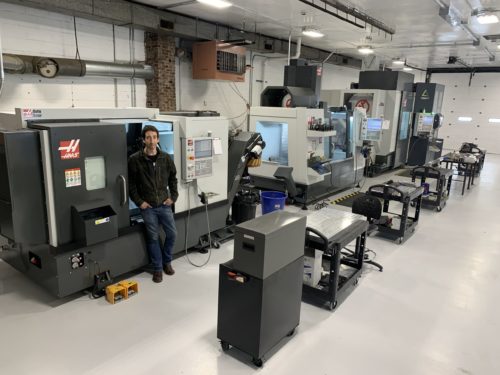Modernizing Manufacturing Education: It’s Up to Us
Hello, reader—Brian Kippen here, owner and founder of KAD, back with another installment of our new series, The Future of Manufacturing. This series spotlights problems we face in the manufacturing industry and what solutions KAD is testing. I hope this will be a collaborative process, and I would love to hear your thoughts on these topics. Drop me a line so we can connect and work to reinvigorate the manufacturing industry together.
How can manufacturing leaders get involved to reinvigorate the industry and help train the next generation of skilled workers?
I’ve asked myself this question, and I’m charting my own path to find the answers. In addition to leading our team here at KAD, I recently took on (another!) day job teaching manufacturing full-time at a local technical school. I wasn’t planning on running a precision machine shop and a classroom simultaneously. But when the opportunity arose over the summer, I knew I had to take it.
I started this blog series because I’m passionate about breathing new life into the manufacturing workforce and closing the skills gap. Teaching at Randolph Technical Career Center (RTCC) seemed like a natural next step.
Being in the classroom and working with students five days a week has allowed me to see firsthand how schools prepare the next generation of skilled workers.
Just a couple of months into the job, I have already recognized a systemic problem that plagues technical schools everywhere and negatively impacts the manufacturing communities seeking to hire graduates. There’s a substantial disconnect between the skills being taught in schools and the skills precision machine shops expect their workers to have.
The Disconnect: Manufacturing Skills Taught vs Skills Needed
Manufacturers want to hire skilled workers who are trained in the latest technologies and can start adding value to their company immediately. However, many technical schools don’t have the resources (i.e., experienced staffing and modern equipment) to prepare students for today’s precision machining jobs.
More often than not, students are taught outdated information on antiquated equipment. Some of that equipment doesn’t even meet today’s safety standards! How can these students then be expected to excel at a modern machine shop that uses new technologies?
Imagine if modern medical schools taught students that amputation is the gold-standard remedy for treating infections on limbs. We would have a generation of doctors convinced that they should remove someone’s arm instead of using antibiotics.
Antiquated equipment isn’t exactly fun to work on, either. In fact, it could turn students off to manufacturing before they even get started. No one likes hot metal chips flying in their face!
The bottom line is that manufacturing educators must introduce students to viable and relevant technologies.
How to Modernize Manufacturing Education in Schools
To better prepare students for manufacturing jobs, educators must be given the funds to modernize the equipment and technologies students are using. But that kind of money isn’t going to come from public schools. . . so that’s where manufacturing leaders come in.
HAAS Automation, Inc. is an excellent example of a manufacturer that genuinely recognizes the importance of educating future generations of workers. The Gene Haas Foundation supports students who are entering tech programs, and the HAAS Factory Outlet provides access to affordable equipment.
Still, outfitting a school with enough modern technology to prepare students for today’s manufacturing jobs is an expensive undertaking. It could cost several hundred thousand dollars for a technical school to purchase updated equipment.
Schools and parents can’t be expected to raise these funds, but you know who can? The people who will directly benefit from the investment: local manufacturers.
An expense of $300,000 could feasibly be split between 10-20 manufacturing companies as an investment in the future. Ideally, students would graduate with the skills necessary to add value to local shops immediately.
If every manufacturing company in the country committed to supporting a local technical trade program in some way, we could improve the standard of manufacturing education and better prepare students to work for us.
The Time to Think BIG Is Now
It’s time to think big, and my early experiences in the classroom only affirm this conviction.
Students in trade schools want to succeed. They come to vocational centers because they want to do something different with their lives. But they don’t know what they don’t know. Many of them are unaware that their experience in a classroom may not paint an accurate picture of a modern precision machine shop.
Of course, I can invite my students to KAD, show them our robots, introduce them to our dogs, and get them excited about a potential job in precision machining. But if their Monday–Friday involves working with outdated equipment, they might lose interest before they graduate.
If we want to inspire the next generation of students to work with us and for us, we must train them in an environment that more closely resembles our shops—where the technology, equipment, and methods are truly cutting edge.
Manufacturing leaders must be the ones to modernize the classrooms. It’s up to us to provide guidance—and funding—to ensure the next generation of workers have the skills and the desire to join our industry.
I encourage all manufacturers to think of one action they can take to support their local trade schools and technical departments. What can you do today to get involved? Are there technical schools in your area that you can support? Are you able to join an advisory board? Together we can reinvigorate the manufacturing industry and inspire the next generation of skilled workers.
I’d love to connect with you about this topic if you have thoughts, suggestions, or solutions. Please feel free to reach out to me so we can continue this conversation.



